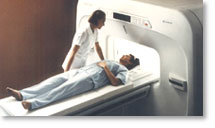 | Info
Sheets |
| | | | | | | | | | | | | | | | | | | | | | | | |
 | Out-
side |
| | | | |
|
| | | | |
Result : Searchterm 'DWI' found in 1 term [ ] and 40 definitions [ ] and 40 definitions [ ] ]
| previous 31 - 35 (of 41) nextResult Pages :  [1] [1]  [2 3 4 5 6 7 8 9] [2 3 4 5 6 7 8 9] |  | |  | Searchterm 'DWI' was also found in the following services: | | | | |
|  |  |
| |
|

From Hitachi Medical Systems America, Inc.; because of its dependability, the MRP-7000™ remains popular more than a decade after the first U.S. system was shipped. This system maintains a high resale value, what has made it one of the most sought-after scanners on the used MRI equipment market.
Device Information and Specification CLINICAL APPLICATION Whole body DualQuad T/R Body Coil, MA Head, MA C-Spine, MA Shoulder, MA Wrist, MA CTL Spine, MA Knee, MA TMJ, MA Flex Body (3 sizes), Neck, small and large Extremity, PVA (WIP), Breast (WIP), Neurovascular (WIP), Cardiac (WIP) and MA Foot//Ankle (WIP) SE, GE, GR, IR, FIR, STIR, ss-FSE, FSE, DE-FSE/FIR, FLAIR, ss/ms-EPI, ss/ms EPI- DWI, SSP, MTC, SE/GE-EPI, MRCP, SARGE, RSSG, TRSG, BASG, Angiography: CE, PC, 2D/3D TOFIMAGING MODES Single, multislice, volume study horizontal 2.5 m x 2.1 m vertical | |  | | | |
|  | |  |  |  |
| |
|
MS-325 is the formerly code name of gadofosveset trisodium (new trade name Vasovist). MS-325 belongs to a new class of blood pool agents for magnetic resonance angiography ( MRA) to diagnose vascular disease. Gadofosveset trisodium has ten times the signal-enhancing power of existing contrast agents as well as prolonged retention in the blood. This enables the rapid acquisition of high resolution MRA's using standard MRI machines.
Gadofosveset trisodium, which is gadolinium-based, stays in the blood stream as a result of transient binding to albumin. Albumin binding offers an additional benefit beyond localization in the blood pool. The contrast agent begins to spin much more slowly, at the rate albumin spins, causing a relaxivity gain that produces a substantially brighter signal than would be possible with freely circulating gadolinium.
MS-325 is an intravascular contrast agent intended for use in MRI as an aid in diagnosing aortoiliac occlusive disease in patients with known or suspected peripheral vascular disease (PVD) or abdominal aortic aneurysm (AAA).
Currently clinical trials completed for peripheral vascular disease and coronary artery disease. Additional trials are also being conducted to evaluate MS-325 as an aid in diagnosing breast cancer and suggested that it might be feasible to combine the use of MS-325, injected during peak stress, with delayed high-resolution imaging to identify myocardial perfusion defects.
Vasovist (MS-325) would compete with the contrast agents Ferumoxytol ( Code 7228) from AMAG Pharmaceuticals, Inc. and NC100150 Injection from Nycomed Amersham, but their further development is uncertain.
Partners in development: EPIX Pharmaceuticals, Inc., Mallinckrodt Inc., and Bayer Schering Pharma AG. Bayer Schering Pharma has the worl dwide marketing rights for the product.
Formerly known under the Mallinckrodt trademark name, AngioMARK®.
See also Classifications, Characteristics, etc. | |  | |
• View the DATABASE results for 'MS-325' (4).
| | |
• View the NEWS results for 'MS-325' (10).
| | | | |  Further Reading: Further Reading: | News & More:
|
|
| |
|  | |  |  |  |
| |
|
| |  | |
• View the DATABASE results for 'Motion Probing Gradient' (2).
| | | | |  Further Reading: Further Reading: | | Basics:
|
|
News & More:
| |
| |
|  |  | Searchterm 'DWI' was also found in the following services: | | | | |
|  |  |
| |
|
| |  | |
• View the DATABASE results for 'Multi Echo Data Image Combination' (2).
| | | | |
|  | |  |  |  |
| |
|
| |  | |
• View the DATABASE results for 'Partial Echo' (4).
| | | | |  Further Reading: Further Reading: | Basics:
|
|
| |
|  | |  |  |
|  | |
|  | | |
|
| |
 | Look
Ups |
| |